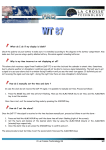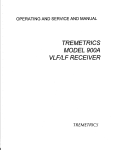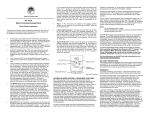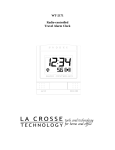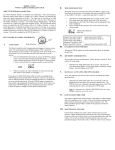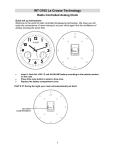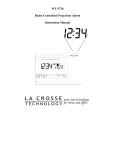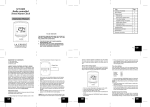Download La Crosse Technology WT-2150A User's Manual
Transcript
Radio Controlled Alarm Clock Introduction: Congratulations on purchasing this Radio Controlled Alarm Clock. Welcome to the world of radio controlled time-keeping technology. We hope you will enjoy the convenience of never having to set your clock again and having the confidence of knowing exactly what time it is. This innovative clock is ideal for home or office use and is loaded with many features. Please read this instruction manual to enjoy the full benefits of all the features. Features: • • • • • • • • • • • • WWVB radio controlled time and date 12 or 24 hour time display Indoor temperature reading (°F/°C user selectable) Two independent alarm times Snooze interval setting from 0 (off) to 59 minutes Calendar display (weekday/month/date or month/date/year) Time zone map for continental United States Time zone selectable –1 hour to –12 hour or Greenwich Mean Time (GMT) LCD back light Manual time setting option Daylight savings time ON/OFF option Low battery indicator Starting up the Alarm Clock The alarm clock uses 1 x AA LR6 battery (Alkaline recommended) Snooze button Function Keys Battery Compartment Battery Cover 1. Slide the battery cover off as indicated by the triangle to open the battery compartment. 2. Insert 1 x AA battery, observing polarity. 3. Replace battery cover. 4. Upon power-up, the alarm will sound once and all LCD segments will light up briefly. 5. The clock will now start searching for the WWVB time signal and the radio tower icon will flash to indicate signal reception attempt. Do not press any buttons at this time. 6. Reception typically takes 6-10 minutes during ideal reception time (nighttime hours) and will timeout after 10 minutes if no signal is found. 7. Upon successful reception, the time and date will be set to absolutely accurate time (default to Eastern time zone). 8. In the case of no reception keep in mind that for most locations reception during daylight hours is not possible. In this case, you may manually set the time or simply wait overnight. Your Radio Controlled Alarm Clock has five easy to use function keys: Use of keys: • Enter the programming mode. • Select and confirm settings while in programming mode. MODE/+: • Toggle between displaying seconds, calendar, alarm times or temperature. • Change or select value while in programming mode. ALM1/HOUR: • Enter the alarm setting mode for alarm 1. • Set Alarm 1 on/off • Set hour while in alarm set mode ALM2/MIN: • Enter the alarm setting mode for alarm 2 • Set Alarm 2 on/off • Set minute while in alarm set mode SNOOZE: • While alarm is sounding, turns off alarm for set time (or off if set to 0) • Turns on back light for LCD (automatic turnoff) SET: SNOOZE Bar ALM1/Hour key ALM2/Minute key SET key MODE/+ key Programming Mode 1) Press the SET key to enter programming mode. 2) Time Zone: Press the MODE/+ key to change the time zone. a) b) c) d) e) Default upon starting is Eastern (-5 GMT) Can be set to –1 to –12 hour and GMT The US map will highlight the time zones set within continental United States (Eastern (-5), Central (-6), Mountain (-7), Pacific (-8)) or “GMT” will be displayed if set to GMT (0). Press the SET key 3) DST: Press the MODE/+ key to switch Daylight Savings Time off or on. The WWVB automatically corrects for DST; “DST” is to be set to “OFF” only in areas that do not follow DST. Press the SET key. 4) Snooze: Press the MODE/+ key to select the desired snooze length from 0 to 59 minutes. Default is 10 minutes; 0 is no snooze (pressing the SNOOZE bar turns off the alarm). Press the SET key. 5) Manual time setting: This is not necessary unless the alarm clock did not pick up a signal upon start up and it is not favorable to wait overnight for time set. If the time is manually set, be sure to set the time to the correct AM/PM time. a) b) c) d) e) f) g) Press the MODE/+ key to set the hour. Press the SET key. Press the MODE/+ key to set the minute. Press the SET key. Press the MODE/+ key to set the year. Press the SET key. Press the MODE/+ key to set the month. Press the SET key. Press the MODE/+ key to set the day. Press the SET key. Press the MODE/+ key to set the weekday. Press the SET key. Press the MODE/+ key to set 12- or 24-hour mode. Press the SET key. 6) Temperature Selection: Press the MODE/+ key to select °F (Fahrenheit) or °C (Celsius). Press the SET key. The programming mode is complete. Alarm Setting Mode 1) Press the ALM1 or ALM2 key for two seconds to enter the Alarm 1 or Alarm 2 setting mode. 2) Press the ALM1/HOUR key to set the alarm hour. 3) Press the ALM2/MIN key to set the alarm minute. 4) Exit this mode by pressing the SNOOZE bar or waiting for 15 seconds. Alarm is activated when ((1)) or ((2)) is displayed to the right of the map. To activate/deactivate an alarm, press the ALM1 or ALM2 key briefly. Display Modes Your alarm clock can be set to display (underneath the US map) either the seconds, calendar, alarm 1 time, alarm 2 time or indoor temperature. 1) Press the MODE/+ key to change the display function. 2) The display will toggle through the options. General Information on WWVB Radio Controlled Time The NIST radio station, WWVB, is located in Ft. Collins, Colorado and transmits the exact time signal continuously throughout the United States at 60 kHz. The signal can be received up to 2,000 miles away through the internal antenna in your alarm clock. However, due to the nature of the Earth’s Ionosphere, reception is very limited during daylight hours. Your alarm clock will search for a signal every night when reception is best. The WWVB radio station derives its signal from the NIST Atomic clock in Boulder, Colorado. A team of atomic physicists continually measures every second of every day to an accuracy of ten billionths of a second a day. These physicists have created an international standard, measuring a second as 9,192,631,770 vibrations of a Cesium 133 atom in a vacuum. This atomic clock regulates the WWVB transmitter. Your Radio Controlled Alarm Clock cannot receive signals from other transmitters in the world (Germany’s DCF 77, Japan’s JG2AS, or England’s MSF-60). Outside the United Sates, the alarm clock will keep time as a precision quartz clock. Troubleshooting The Radio Controlled Alarm Clock is designed to be simple to operate yet offer a complete range of features. Some common questions are listed below. Q: I inserted a battery, but the time did not set; what’s wrong? A: In many areas of the country a signal cannot be received during daylight hours due to the interference of the sun. By leaving the clock alone, a signal will be found during the night and the alarm clock will be set to the absolutely correct time and date by the next morning. When a signal is received, the radio tower icon is displayed to the left of the US map. If no signal is received, there will be no tower icon. Q: Why hasn’t my alarm clock picked up a signal? A: Short-term interference can be caused by storms between you and Colorado during reception time. There is interference between the Alarm Clock and the signal from Colorado. Be sure to keep the alarm clock at least six feet from any electrical device (computers, television sets, other radio-controlled clocks, etc.). Avoid placing alarm clock on metal surfaces. The ideal location for signal reception is in a window facing Colorado. Q: Can I set the time and date without waiting for a signal? A: Yes; simply follow the “Programming Mode” directions. Q: How often does the alarm clock synchronize with the WWVB? A: The Alarm Clock searches for a signal immediately after inserting a battery. After an initial signal is received, the alarm searches for a signal starting at 12:00 AM (midnight) every night and synchronizes at that time. Q: After the clock set itself, why does it show the wrong hour? A: The time zone is not set correctly. Look on the LCD map to see if the proper time zone is highlighted. If not, follow the “Programming Mode” section. Q: What does “DST ON/OFF” mean? A: Some parts of the country do not follow Daylight Savings Time (Arizona and parts of Indiana). Since the WWVB signal includes the correction for this, these areas must have the DST OFF. Care and Maintenance • Extreme temperatures, vibration and shock should be avoided as these may cause damage to the unit and could give inaccurate readings. • Use a soft, dry cloth to clean alarm clock. Do not use solvents as they may mark the LCD and case. • Do not expose alarm to water or high humidity. • Immediately remove low powered battery to avoid leakage and replace with one fresh AA LR6 battery. • Do not attempt to repair your alarm clock. Battery Change Specifications: • It is recommended to replace the battery on an annual basis to ensure optimum accuracy or when the battery icon indicates low running power. • When replacing the battery, be sure to leave battery out for at least one minute to allow complete reset. • Place battery firmly in compartment to ensure proper contact. Time Source/Frequency Temperature measuring range : : Temperature resolution Temperature checking interval Power source Battery life cycle Dimensions (L x W x H) : : : : : WWVB/60 kHz -21.8°F to +155.9°F (-29.9°C to +68.8°C) 0.2°F (0.1°C) Every 10 seconds 1 x AA, IEC LR6, 1.5V Alkaline Approximately 12 months 3.70 x 3.50 x 1.91 in (95 x 90 x 49 mm) For warranty work, technical support, or information, contact La Crosse Technology at: La Crosse Technology, Ltd 2809 Losey Blvd. S. La Crosse, WI 54601 Phone: 608.782.1610 Fax: 608.796.1020 e-mail: [email protected] (warranty work) [email protected] (information on other products) web: www.lacrossetechnology.com THIS DEVICE COMPLIES WITH PART 15 OF THE FCC RULES. OPERATION IS SUBJECT TO THE FOLLOWING TWO CONDITIONS: 1. 2. THIS DEVICE MAY NOT CAUSE HARMFUL INTERFERENCE, AND THIS DEVICE MUST ACCEPT INTERFERENCE RECEIVED, INCLUDING INTERFERENCE THAT MAY CAUSE UNDESIRED OPERATION. Radio controlled Alarm Clock Horloge radio-commandée Despertador Controlado por emisiones de Radio Instructions Manual Manual de instrucciones Livret d'instructions Canada Mountain Time (-7h GMT) Central Time Pacific Time (-6h GMT) (-8h GMT) Eastern Time United States (-5h GMT) Mexico








